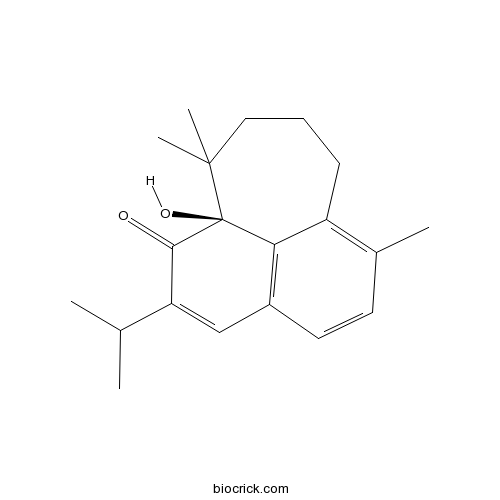MicrostegiolCAS# 143246-41-7 |

Quality Control & MSDS
3D structure
Package In Stock
Number of papers citing our products

| Cas No. | 143246-41-7 | SDF | Download SDF |
| PubChem ID | 403772 | Appearance | Powder |
| Formula | C20H26O2 | M.Wt | 298.4 |
| Type of Compound | Diterpenoids | Storage | Desiccate at -20°C |
| Solubility | Soluble in Chloroform,Dichloromethane,Ethyl Acetate,DMSO,Acetone,etc. | ||
| SMILES | CC1=C2CCCC(C3(C2=C(C=C1)C=C(C3=O)C(C)C)O)(C)C | ||
| Standard InChIKey | KIXMQGXACFNMEM-FQEVSTJZSA-N | ||
| Standard InChI | InChI=1S/C20H26O2/c1-12(2)16-11-14-9-8-13(3)15-7-6-10-19(4,5)20(22,17(14)15)18(16)21/h8-9,11-12,22H,6-7,10H2,1-5H3/t20-/m0/s1 | ||
| General tips | For obtaining a higher solubility , please warm the tube at 37 ℃ and shake it in the ultrasonic bath for a while.Stock solution can be stored below -20℃ for several months. We recommend that you prepare and use the solution on the same day. However, if the test schedule requires, the stock solutions can be prepared in advance, and the stock solution must be sealed and stored below -20℃. In general, the stock solution can be kept for several months. Before use, we recommend that you leave the vial at room temperature for at least an hour before opening it. |
||
| About Packaging | 1. The packaging of the product may be reversed during transportation, cause the high purity compounds to adhere to the neck or cap of the vial.Take the vail out of its packaging and shake gently until the compounds fall to the bottom of the vial. 2. For liquid products, please centrifuge at 500xg to gather the liquid to the bottom of the vial. 3. Try to avoid loss or contamination during the experiment. |
||
| Shipping Condition | Packaging according to customer requirements(5mg, 10mg, 20mg and more). Ship via FedEx, DHL, UPS, EMS or other couriers with RT, or blue ice upon request. | ||
| Description | 1. Migrostegiol has a little activity against B. subtilis. |
| Targets | Antifection |

Microstegiol Dilution Calculator

Microstegiol Molarity Calculator
| 1 mg | 5 mg | 10 mg | 20 mg | 25 mg | |
| 1 mM | 3.3512 mL | 16.756 mL | 33.5121 mL | 67.0241 mL | 83.7802 mL |
| 5 mM | 0.6702 mL | 3.3512 mL | 6.7024 mL | 13.4048 mL | 16.756 mL |
| 10 mM | 0.3351 mL | 1.6756 mL | 3.3512 mL | 6.7024 mL | 8.378 mL |
| 50 mM | 0.067 mL | 0.3351 mL | 0.6702 mL | 1.3405 mL | 1.6756 mL |
| 100 mM | 0.0335 mL | 0.1676 mL | 0.3351 mL | 0.6702 mL | 0.8378 mL |
| * Note: If you are in the process of experiment, it's necessary to make the dilution ratios of the samples. The dilution data above is only for reference. Normally, it's can get a better solubility within lower of Concentrations. | |||||

Calcutta University

University of Minnesota

University of Maryland School of Medicine

University of Illinois at Chicago

The Ohio State University

University of Zurich

Harvard University

Colorado State University

Auburn University

Yale University

Worcester Polytechnic Institute

Washington State University

Stanford University

University of Leipzig

Universidade da Beira Interior

The Institute of Cancer Research

Heidelberg University

University of Amsterdam

University of Auckland

TsingHua University

The University of Michigan

Miami University

DRURY University

Jilin University

Fudan University

Wuhan University

Sun Yat-sen University

Universite de Paris

Deemed University

Auckland University

The University of Tokyo

Korea University
- (-)-Isolariciresinol 9'-O-glucoside
Catalog No.:BCN7708
CAS No.:143236-04-8
- (-)-Lyoniresinol 9'-O-glucoside
Catalog No.:BCN7037
CAS No.:143236-02-6
- Z-2-Nal-OH
Catalog No.:BCC3291
CAS No.:143218-10-4
- Dehydroadynerigenin beta-neritrioside
Catalog No.:BCN4706
CAS No.:143212-60-6
- 7-Geranyloxy-5-methoxycoumarin
Catalog No.:BCN5806
CAS No.:1432075-68-7
- (Z)-3-Hydroxy-5-methoxystilbene
Catalog No.:BCN6688
CAS No.:143207-76-5
- 10-O-Acetylisocalamendiol
Catalog No.:BCN7071
CAS No.:1432064-69-1
- 6-O-Acetylcoriatin
Catalog No.:BCN7048
CAS No.:1432063-63-2
- 8-Isomulberrin hydrate
Catalog No.:BCC8789
CAS No.:1432063-35-8
- 3-(3-Hydroxy-3-methylbutanyl)-2,4,6-trihydroxybenzophenone
Catalog No.:BCC8588
CAS No.:1432062-53-7
- 10-Acetoxyscandine
Catalog No.:BCN7035
CAS No.:1432058-90-6
- Catalponol methylthiomethyl ether
Catalog No.:BCC8905
CAS No.:1432057-74-3
- Tin protoporphyrin IX dichloride
Catalog No.:BCC6776
CAS No.:14325-05-4
- LDN-212854
Catalog No.:BCC5330
CAS No.:1432597-26-6
- AGI-6780
Catalog No.:BCC1331
CAS No.:1432660-47-3
- RA-XI
Catalog No.:BCN3514
CAS No.:143277-27-4
- H-Chg-OH
Catalog No.:BCC3162
CAS No.:14328-51-9
- Ac-YVAD-CHO
Catalog No.:BCC4021
CAS No.:143313-51-3
- UNC 2400
Catalog No.:BCC5625
CAS No.:1433200-49-7
- RS 56812 hydrochloride
Catalog No.:BCC6877
CAS No.:143339-12-2
- SMIP004
Catalog No.:BCC1955
CAS No.:143360-00-3
- Bryostatin 3
Catalog No.:BCC5620
CAS No.:143370-84-7
- Naratriptan
Catalog No.:BCC5053
CAS No.:143388-64-1
- SAR131675
Catalog No.:BCC5097
CAS No.:1433953-83-3
Components and antibacterial activity of the roots of Salvia jaminiana.[Pubmed:15893885]
Fitoterapia. 2005 Jul;76(5):450-2.
The acetone extract of the roots of Salvia jaminiana, containing the sterols campestanol, stigmasterol and sitosterol, and five known diterpenoids, ferruginol, cryptanol, 6,7-dehydroroyleanon, 6-hydroxysalvinolone and Microstegiol, remarkably inhibited the growth of Bacillus subtilis, Staphylococcus aureus ATCC 25923 and Streptococcus alpha-hemolitic.
Antibacterial diterpenes from the roots of Salvia viridis.[Pubmed:10909268]
Planta Med. 2000 Jun;66(5):458-62.
Three new diterpenes, salviviridinol, viridinol, viridone, five known diterpenes, sugiol, 1-oxoferruginol, ferruginol, aethiopinone and Microstegiol, abietane and rearranged abietane diterpenes were isolated from the roots of Salvia viridis. These compounds were assayed against S. aureus ATCC 6538 P, E. coli ATCC 8739, P. mirabilis ATCC 14153, K. pneumonia ATCC 4352, P. aeruginosa ATCC 27853, S. epidermidis ATCC 12228, E. faecalis ATCC 29212 and a yeast C. albicans ATCC 10231. 1-Oxoferruginol showed activity against B. subtilis, S. aureus, S. epidermidis and a modest activity against P. mirabilis, migrostegiol had a little activity against B. subtilis. The structures of the compounds were established by 1D and 2D NMR spectroscopic techniques.


